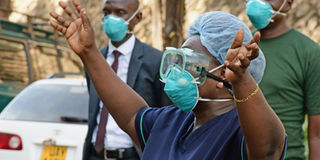How to prevent coronavirus-related stigma

Education. A health worker during a sensitisation drive about preventive measures against coronavirus at Mulago hospital recently. Photo by Rachel Mabala
What you need to know:
- The organisations say the pandemic has provoked social stigma against people of certain ethnic backgrounds as well as anyone perceived to have been in contact with the virus.
- According to the guidelines, when talking about coronavirus, certain words such as suspect case, isolation and language may have a negative meaning for people and fuel stigmatising attitudes.
Ugandans who have been abroad recently have faced several challenges, including social stigma because they are associated with the spread of the dreaded Covid-19 pandemic in the country.
Many have gone into unintended seclusion and self-isolation because of fear of attacks by locals who view them as agents of spread of the virus.
A guide issued by International Federation of Red Cross, Unicef and World Health Organisation defines social stigma in the context of health as the negative association between a person or group of people who share certain characteristics and a specific disease.
The guideline also states that such treatment can negatively affect their caregivers, family, friends and communities.
The organisations say the pandemic has provoked social stigma against people of certain ethnic backgrounds as well as anyone perceived to have been in contact with the virus.
According to the guidelines, when talking about coronavirus, certain words such as suspect case, isolation and language may have a negative meaning for people and fuel stigmatising attitudes.
They can perpetuate existing negative stereotypes or assumptions, strengthen false associations between the disease and other factors, create widespread fear, or dehumanise those who have the disease.
This, the guidelines concludes, can drive people away from getting screened, tested and quarantined.
“We recommend a ‘people first’ language that respects and empowers people in all communication channels, including the media. Words used in media are especially important because these will shape the popular language and communication on the new coronavirus.
Negative reporting has the potential to influence how people suspected to have the new coronavirus, patients and their families and affected communities are perceived and treated,” the guide states.
Dos and dont’s
•Talk about the new coronavirus disease. Do not attach locations or ethnicity to the disease, this is not a “Wuhan Virus”, “Chinese Virus” or “Asian Virus”. The official name for the disease was deliberately chosen to avoid stigmatisation - the “co” stands for Corona, “vi” for virus and “d” for disease, 19 is because the disease emerged in 2019.
•Talk about “people who have Covid-19”, “people who are being treated for Covid-19”, “people who are recovering from Covid-19” or “people who died after contracting Covid-19”. Don’t refer to people with the disease as “Covid-19 cases” or “victims”.
•Talk about “people who may have Covid-19” or “people who are presumptive for Covid-19”. Don’t talk about “Covid-19 suspects” or “suspected cases”.
•Talk about people “acquiring” or “contracting” Covid-19. Do not talk about people “transmitting Covid-19” “infecting others” or “spreading the virus” as it implies intentional transmission and assigns blame. •Do speak accurately about the risk from Covid-19, based on scientific data and latest official health advice. Do not - repeat or share unconfirmed rumours, and avoid using hyperbolic language designed to generate fear like “plague”, “apocalypse” etc.
•Do talk positively and emphasise the effectiveness of prevention and treatment measures.
Examples and tips on possible actions to counter stigmatising attitudes
•Prioritise the collection, consolidation and dissemination of accurate country- and community-specific information about affected areas, individual and group vulnerability to Covid-19, treatment options and where to access health care and information.
•Engaging social influencers such as religious leaders on prompting reflection about people who are stigmatised and how to support them.
•Amplify the voices, stories and images of local people who have experienced Covid-19 and have recovered or who have supported a loved one through recovery to emphasise that most people do recover from the disease.
COVID-19. Also, implementing a “hero” campaign honouring caretakers and healthcare workers who may be stigmatized. Community volunteers also play a great role in reducing stigma in communities.
• Make sure you portray different ethnic groups. All materials should show diverse communities being impacted and working together to prevent the spread of COVID-19. Ensure that typeface, symbols and formats are neutral and don’t suggest any particular group.
• Ethical journalism: Journalistic reporting which overly focuses on individual behaviour and patients’ responsibility for having and “spreading COVID-19” can increase stigma of people who may have the disease. Promote content around basic infection prevention practices, symptoms of COVID-19 and when to seek health care.
• Link up: There are a number of initiatives to address stigma and stereotyping. It is key to link up to these activities to create a movement and a positive environment that shows care and empathy for all.
• Communicate support and encouragement for those who are on the frontlines of response to this outbreak (health care workers, volunteers, community leaders.
• Facts, not fear will stop the spread of COVID-19. Share facts and accurate information about the disease. Challenge myths and stereotypes. Choose words carefully. The way we communicate can affect the attitudes of others.



